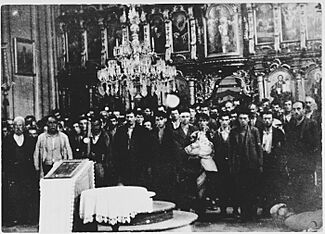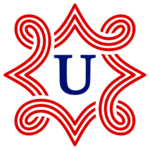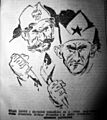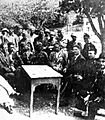Ustaše facts for kids
Quick facts for kids
Ustaša – Croatian Revolutionary Movement
Ustaša – Hrvatski revolucionarni pokret
|
|
|---|---|
 |
|
| Governing body | Main Ustaša Headquarters |
| Founders | Ante Pavelić Vjekoslav Servatzy Slavko Kvaternik |
| Founded |
|
| Dissolved | 25 May 1945 (de facto) |
| Preceded by | Members of the defunct Croatian Committee Radical Frankist wing of the Party of Rights |
| Succeeded by | Various emigre groups |
| Headquarters | |
| Newspaper | Hrvatski Domobran |
| Think tank | Hrvatski Domobran |
| Youth wing | Ustaše Youth (UM) |
| Paramilitary wing | Ustaše Militia |
| Membership | 100,000 (1941 est.) |
| Ideology | Ustašism
|
| Political position | Far-right |
| Religion | Roman Catholicism, Islam |
| Colours | Red White Blue Black |
| Slogan | "Za dom spremni" ("For the home—Ready!") |
| Anthem | Puška puca |
The Ustaše (pronounced: OO-stah-sheh) was a Croatian political group active from 1929 to 1945. Its full name was the Ustaša – Croatian Revolutionary Movement. This group was known for its extreme nationalist and fascist ideas.
Before World War II, the Ustaše carried out violent acts against the Kingdom of Yugoslavia. They even worked with another group to assassinate King Alexander I of Yugoslavia in 1934. During World War II, the Ustaše were responsible for terrible crimes. They killed hundreds of thousands of Serbs, Jews, and Roma people. They also targeted Croats and Bosniaks who disagreed with them.
The Ustaše believed in creating a "Greater Croatia." This new state would stretch to the Drina River and near Belgrade. They wanted a "racially pure" Croatia. This meant they wanted to get rid of Serbs, Jews, and Roma. They saw Bosniaks as "Muslim Croats" and generally did not persecute them based on race. The Ustaše favored Roman Catholicism and Islam. They did not like Orthodox Christianity, which was the main religion of Serbs.
The Ustaše started as a group that wanted an independent Croatian state. They used violence to achieve their goals before the war. In April 1941, after Yugoslavia was invaded, the Ustaše came to power. They were put in charge of a part of occupied Yugoslavia. This new state was called the Independent State of Croatia (NDH). It was a puppet state supported by Fascist Italy and Nazi Germany. The Ustaše Militia became its military.
The Ustaše government was not very strong. It did not have much support from most Croats. They used terror to control the people. At first, some Croats supported them because they felt unfairly treated by the Serb-led Yugoslavia. But the Ustaše's brutal actions quickly made many ordinary Croats turn against them.
When Germany surrendered in 1945, the Ustaše movement and their state collapsed. Many Ustaše members fled. Some were captured and killed during the Bleiburg repatriations. After the war, some former Ustaše tried to continue their movement, but they were not successful.
Contents
What Does "Ustaše" Mean?
The word ustaša comes from the Croatian verb ustati. This means "to rise up." The term "ustaša" was used in the past for rebels. For example, it described those who fought in the Herzegovinian rebellion of 1875.
The group's first full name was the Ustaša – Croatian Revolutionary Organization. This was in April 1931. In 1933, it changed to the Ustaša – Croatian Revolutionary Movement. This name stayed until World War II.
What Did the Ustaše Believe?
Influences on Their Ideas
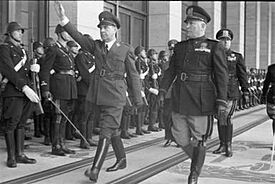

The Ustaše's ideas were shaped by earlier Croatian thinkers. One key person was Ante Starčević from the 1800s. He wanted Croatia to be united and independent. He was against both the Habsburg rulers and Serbs.
Starčević imagined a "Greater Croatia." This would include areas where Bosniaks, Serbs, and Slovenes lived. He believed Bosniaks and Serbs were Croats who had changed their religion. He called Slovenes "mountain Croats." The Ustaše used these ideas to claim Bosnia and Herzegovina for Croatia.
The Ustaše were also greatly influenced by Nazism and Italian Fascism. Their leader, Ante Pavelić, used the title Poglavnik. This was similar to Duce for Benito Mussolini in Italy and Führer for Adolf Hitler in Germany. Mussolini even gave Pavelić a safe place in Italy when he was exiled.
Germany did not initially support an independent Croatia. Hitler wanted a strong Yugoslavia. But the Ustaše later came under German influence.
Main Goals and Plans
In 1933, the Ustaše shared their "Seventeen Principles." These ideas said that the Croatian nation was special. They put the rights of the group above individual rights. They also said that people who were not Croatian by "blood" could not be part of political life.
People they called "undesirables" were often killed. The Ustaše wanted a new economic system. It would be neither capitalist nor communist. They also stressed the importance of the Roman Catholic Church and the family.
The Ustaše believed Croats were part of the Dinaric race. But they did not think Croats were mainly Slavic. They claimed Croats came from Germanic groups like the Goths. The Ustaše believed a government should be strong and authoritarian. They were against parliamentary democracy and Marxism.
The Ustaše recognized both Roman Catholicism and Islam as national religions. They initially rejected Orthodox Christianity. Once in power, they banned the term "Serbian Orthodox faith." They forced many Orthodox Christians to convert to Catholicism. They also killed or expelled many Orthodox priests.
Why Did They Hate Jews?
At first, the Ustaše mainly focused on Serbs. But as they got closer to the Nazis, they also became very anti-Jewish. Ante Pavelić wrote in 1936 that Jews were among the "Enemies of the Croats." He claimed Jews controlled finance and trade in Croatia.
When the Ustaše took power, they quickly made racial laws like those in Nazi Germany. These laws said who was Jewish. They took away citizenship rights from all non-Aryans, like Jews and Roma. By April 1941, Jews had to wear a yellow Star of David. The Ustaše also took all Jewish property.
They started arresting Jewish people and destroying synagogues. Ustaše newspapers spread hateful messages. They said Croatians must keep their "blood clean of the Jews." They also claimed Jews were linked to "treachery, cheating, greed, immorality."
Many Jews were sent to Ustaše and Nazi concentration camps. The most well-known was the Ustaše-run Jasenovac concentration camp. Almost 32,000 Jews, or 80% of the Jews in the Independent State of Croatia, were killed.
How Did They View Muslims?
The Ustaše praised Islam. They said it "keeps true the blood of Croats." They called Bosniaks "Muslim Croats." Because of this, Muslims were generally not persecuted based on race or religion.
However, Muslims were not completely safe from Ustaše violence. The Ustaše said that a Muslim who supported Yugoslavia was not a Croat citizen. Most Muslims were neutral or against the Ustaše government.
A Brief History
Before World War II
In the 1920s, Ante Pavelić became a key leader for Croatian independence. He secretly met with Benito Mussolini in 1927. Pavelić wanted an independent "Greater Croatia."
In 1928, after a Croatian politician was killed, a youth group formed. Pavelić joined it. They started a newspaper called Hrvatski Domobran. This newspaper supported Croatian national ideas. In 1929, the king banned all national parties. Pavelić and others went into exile.
The Ustaše started carrying out terrorist acts. They planted bombs on trains going to Yugoslavia. In November 1932, Ustaše members attacked a police outpost. This was called the "Velebit uprising."
The King's Assassination
The Ustaše's most famous act of terror happened on October 9, 1934. They worked with another group to kill King Alexander I of Yugoslavia in France. The person who carried out the killing was killed by French police. Three Ustaše members were caught and sentenced to life in prison. Pavelić and others were sentenced to death in their absence.
The Ustaše believed this assassination "broke the backbone of Yugoslavia." After this, Ustaše groups were banned across Europe. Pavelić was arrested in Italy but released in 1936. He said the assassination was "the only language Serbs understand."
Over time, a split grew between Ustaše members who stayed in Croatia and those who went abroad. The "emigre" Ustaše were seen as more violent. In the late 1930s, the Ustaše started joining other Croatian groups. By 1939, an Ustaše-linked student group was very popular at the University of Zagreb.
During World War II
The Axis powers invaded Yugoslavia on April 6, 1941. On April 10, a Ustaše leader named Slavko Kvaternik announced the creation of the Independent State of Croatia (NDH). The name was meant to show Croatia's fight for independence.
Pavelić returned to Zagreb and formed a new government on April 16, 1941. He called himself "Poglavnik." The NDH claimed land that is now Croatia, Bosnia and Herzegovina, and other areas. However, the Ustaše had to give up some land to Italy. The Germans and Italians divided the NDH into two zones of influence.
Support for the Ustaše government among Croats began to drop. This happened after they gave land to Italy and because of their violent actions.
Ustaše Military Actions
The Ustaše Militia was formed in 1941. Its members were mostly uneducated people and workers. On April 27, 1941, a new Ustaše unit killed Serbs in a village. The Ustaše outlawed anyone who opposed them. They banned the Croatian Peasant Party in June 1941.
In the early months of the NDH, many Ustaše groups were not controlled by the central government. These "Wild Ustaše" committed many crimes against Serbs. The government tried to stop them. They even executed some "Wild Ustaše" for uncontrolled violence.
Pavelić met with Adolf Hitler in June 1941. A minister in Pavelić's government, Mile Budak, announced the state's violent racial policy. Concentration camps were built. German and Italian officers were often shocked by the Ustaše's brutality. A German report in 1942 said Ustaše actions against Orthodox Serbs were "bestial." It claimed about 300,000 Orthodox Serbs had been killed.
By 1944, Pavelić relied almost completely on Ustaše units. These units grew to 100,000 members. Fighting continued after Germany surrendered in May 1945. Pavelić ordered his forces to try to escape to Austria. Many Ustaše and civilians were captured and killed by the Partisans. Pavelić himself hid in Austria and Rome before fleeing to Argentina.
After the War
After World War II, many Ustaše members went into hiding or fled. They went to countries like Canada, Australia, Germany, and South America. They often got help from Catholic churches.
Some Ustaše tried to form a resistance group called the Crusaders. But their efforts were stopped by Yugoslav authorities. The Ustaše movement became inactive. Pavelić formed the Croatian Liberation Movement.
On April 9, 1957, Pavelić was shot in Argentina. He later died from his injuries.
Targeting Groups of People
The Ustaše wanted to create an ethnically "pure" Croatia. They saw Serbs in Croatia and Bosnia as the biggest problem. Ustaše ministers said in May 1941 that their goal was a pure Croatia. Their plan was:
- Kill one-third of the Serbs.
- Expel one-third of the Serbs.
- Force one-third of the Serbs to convert to Roman Catholicism.
The NDH government worked with Nazi Germany in the Holocaust. They also carried out their own genocide against Serbs, Jews, and Roma. They passed racial laws like those in Nazi Germany. These laws targeted Jews, Roma, and Serbs. They were all called enemies of the Croatian people.
Serbs, Jews, Roma, and Croats who opposed the Ustaše were sent to concentration camps. The largest was Jasenovac concentration camp. By the end of the war, the Ustaše had killed an estimated 30,000 Jews and 26,000–29,000 Roma. The number of Serb victims is estimated to be between 200,000 and 500,000. Historians usually say between 300,000 and 350,000 Serbs died.
The United States Holocaust Memorial Museum says that determining the exact number of victims is hard. Many documents were destroyed. They estimate that between 320,000 and 340,000 ethnic Serbs were killed in Croatia and Bosnia. They also state that more than 30,000 Croatian Jews were killed.
The Jasenovac Memorial Area has a list of 83,145 victims. They believe this is 60%–75% of the total. This puts the total killed at Jasenovac between 80,000 and 100,000.
Concentration Camps
The Ustaše set up many concentration camps. The first ones were formed in the spring of 1941. These included:
- Danica
- Slana
- Jadovno
- Kruščica
- Đakovo
- Loborgrad
- Tenja
These early camps closed by October 1942. The Jasenovac concentration camp complex was built between 1941 and 1942. It continued to operate until the end of the war. Other camps included Sisak concentration camp and Jastrebarsko children's camp.
Mass Killings of Serb Civilians
The Ustaše also carried out many mass killings of civilians outside the camps. The first large killing of Serbs happened on April 30, 1941. The Ustaše rounded up and killed 196 Serb villagers at Gudovac. Many other massacres followed in places like Blagaj and Glina.
German officers in Croatia often said they were horrified by the Ustaše's mass killings. A German general reported that 250,000 Serbs had been killed by March 1943. Another general heard an Ustaše official claim the number was "not higher than 200,000."
Religious Persecution
As part of their plan to eliminate Serbs, the Ustaše forced Orthodox Serbs to convert to Catholicism. Catholic priests sometimes took part in these conversions. Sometimes, the Ustaše used the idea of conversion to gather Serbs, only to kill them. This happened in Glina.
The Ustaše killed 157 Orthodox priests and jailed the Orthodox archbishop of Zagreb. They expelled many other priests to Serbia. They destroyed and damaged many Orthodox churches. They also banned the Cyrillic script and the Julian calendar, which are used in the Orthodox Church. Orthodox schools were closed. The Ustaše confiscated Orthodox Church property.
To destroy the Serbian Orthodox Church, the Ustaše tried to create their own Croatian Orthodox Church. But this new church gained very few followers.
Historian Jozo Tomasevich found no public or private condemnations of these crimes by Catholic Archbishop Stepinac or other Croatian Catholic Church members. He stated that many Croatian Catholic priests approved of these attacks.
Links with the Catholic Church
Historically, the Catholic Church was not very involved in Croatian politics. But during the Ustaše regime, this changed. The Croatian Catholic Church was unhappy with the previous Yugoslav government. They felt they were treated unfairly compared to the Serbian Church.
The Ustaše's hatred for Serbs was linked to the Croatian Catholic Church's dislike of the Orthodox Church. The Ustaše supported forcing Orthodox believers to become Roman Catholic. They believed Orthodox Christianity was a symbol of Serbian nationalism.
Some Catholic priests, especially in Bosnia, took part in the violence. Priests like Ivan Guberina were bodyguards for Pavelić. Dionizije Juričev, who was in charge of forced conversions, wrote that it was not a crime to kill seven-year-olds if they stood in the way of the Ustaše.
On April 28, 1941, the head of the Catholic Church in Croatia, Archbishop Alojzije Stepinac, publicly supported the new Independent State of Croatia. He asked clergy to pray for Ante Pavelić. This happened even though the Ustaše had already started banning Serbs, Jews, and Roma from public jobs.
While Stepinac later spoke out against some Ustaše policies and helped some Jews and Serbs, he continued to publicly support the NDH until the end. He even received a medal from Pavelić in 1944. Some historians say Stepinac hated Pavelić and opposed Nazi ideas. Other Catholic clergy also helped save Jews.
However, the majority of Catholic clergy in Croatia supported the Ustaše at first. Later, as the Allies began to win, the Church tried to distance itself from the regime. But in March 1945, the Croatian Catholic Church still supported the puppet state. Stepinac himself held a final service for the NDH on April 10, 1945. This was while the NDH was carrying out the final killings at Jasenovac concentration camp.
Some priests, especially Franciscans, were directly involved in the violence. Miroslav Filipović was a Franciscan friar. He allegedly joined the Ustaše as a chaplain and took part in a massacre of Serbs, including children. He was later removed from his order. He became a chief guard at Jasenovac concentration camp. There, he was nicknamed "Father Satan."
After World War II, Ustaše members who escaped Yugoslavia were smuggled to South America. This was often done through "ratlines" run by Catholic priests who had positions at the Vatican.
The Ustaše regime had put large amounts of gold, taken from Serbs and Jews, into Swiss bank accounts. Some reports suggest a lot of this gold reached the Vatican. This issue remains unclear.
Cardinal Alojzije Stepinac was later accused by Yugoslav authorities of supporting the Ustaše. He was sentenced to prison. Stepinac had said that Croats and Serbs were "two worlds" and could never get along. In 2016, his conviction was overturned. In 1998, Pope John Paul II made Stepinac a "blessed" person.
Ustaše and Chetnik Cooperation
The Ustaše and Chetniks were opposing nationalist groups. But they sometimes worked together against their common enemy, the Partisans. This cooperation started in the spring of 1942 and lasted until the end of the war.
These agreements stated that Chetnik groups would help the Croatian armed forces fight the Partisans. They would be under Croatian command during these operations. The NDH military would supply the Chetniks with weapons and ammunition. Wounded Chetniks would be treated in NDH military hospitals. Widows and orphans of killed Chetnik soldiers would receive financial aid.
The NDH authorities even released Serbs from Ustaše concentration camps. But this only happened if Chetnik commanders specifically recommended it. Ustaše and Chetniks fought together with German and Italian forces in major battles against the Partisans.
In 1945, a Chetnik commander and his troops escaped through the NDH with Pavelić's permission. Pavelić also met with two generals from the Chetnik leader Draža Mihailović. They agreed to fight Tito's communists together.
How the Ustaše Were Organized
The leader of the Ustaše was Poglavnik Ante Pavelić. He was appointed Head of State of Croatia in April 1941. The Army of the Independent State of Croatia was the official armed force. It later merged with Ustaše units. The Ustaše also had command structures at different local levels.
Symbols of the Ustaše
The Ustaše symbol was a blue capital letter "U" with an exploding grenade inside it.
The flag of the Independent State of Croatia was red, white, and blue. It had the Croatian coat of arms in the middle and the "U" symbol in the upper left corner. Their money was called the NDH kuna.
The Ustaše greeting was "Za dom – spremni!" This means "For home(land) – (We are) ready!" They used this instead of the Nazi greeting "Heil Hitler." Today, this greeting is linked to Ustaše supporters. But some Croats see it as a patriotic salute.
What is Their Legacy Today?
In Modern-Day Croatia
After Croatia became independent in the 1990s, some streets were named after Ustaše leaders. While some names were later changed, many still remain.
Jewish and Serb groups, historians, and anti-fascists have warned about attempts to minimize Ustaše crimes. There have been books and documentaries that try to make Ustaše actions seem less severe. Some Croatian Catholic Church sources have also been accused of minimizing these crimes. In 2013, a Croatian Catholic newspaper published articles claiming Jasenovac was just a "work-camp."
Croatian soccer fans have sometimes used the Ustaše "Za dom spremni" salute. This has led to penalties against the Croatian soccer federation. In 2014, a Croatian soccer player was banned from the World Cup for leading fans in this salute.
In 2014, a monument was put up in Split, Croatia. It was dedicated to a brigade named after an Ustaše commander. The monument includes the "Za dom spremni" salute. Organizations linked to this brigade hold yearly events on April 10, the anniversary of the NDH's founding. During these events, participants in black uniforms shout the Ustaše salute.
In 2016, a plaque with the "Za dom spremni" salute was placed at Jasenovac concentration camp. After protests, it was moved to a nearby town. Because of this, Jewish, Serb, and Croatian WWII resistance groups refused to attend the annual Jasenovac commemoration with government officials.
In 2019, Austria banned the display of Ustaše symbols. This was because Croatian nationalists displayed them at an annual event in Bleiburg. Austrian police have arrested people for using Nazi and fascist salutes there. The Austrian Catholic Church banned a Mass at Bleiburg. They said it was being used for political reasons and did not distance itself from fascist views.
How the Term "Ustaše" is Used Today
After World War II, the Ustaše movement broke into different groups. No current political group claims to be their direct successor. Today, "ustaše" is often used as a negative term for extreme Croatian nationalism. Serbs sometimes use it to describe anti-Serb feelings or to criticize political opponents.
Use by Serbian Nationalists
Since World War II, Serbian historians have used the Ustaše story. They often say that Serbs resisted the Axis, while Croats and Bosniaks widely supported them. However, the Ustaše did not have much support among ordinary Croats. Their brutal actions made them lose the support they had gained.
In the 1980s, Serbian historians wrote a lot about forced conversions of Serbs to Catholicism during the war. These discussions became very nationalistic. Serbian clergy and nationalists blamed all Croats for Ustaše crimes. These actions were aimed at justifying planned crimes and ethnic changes in Croatia.
Images for kids
-
A unit of Ustaše in Sarajevo
-
Nazi SS recruitment poster used in the NDH
-
Marko Došen (far left, giving Nazi salute) and Archbishop Alojzije Stepinac (far right)
-
Young boy wearing a shirt with a Black Legion, Ustaše Militia sign at a Thompson concert


